Earthquake Resistant Building: Design, Construction, and Analysis
VerifiedAdded on 2023/06/03
|16
|3000
|86
Report
AI Summary
This report examines the design and construction of earthquake-resistant buildings, addressing the impact of earthquakes on reinforced concrete structures and exploring technologies for low-cost, earthquake-resistant construction. It reviews methods for measuring earthquakes, analyzes structural framing requirements for safety, and discusses practices like using waste tire pads for seismic isolation. The research methodology involves a review of secondary sources and mathematical models. The report emphasizes the importance of understanding earthquake behavior to minimize damage and casualties through effective structural design and construction. Desklib provides a platform to access this document along with numerous past papers and solved assignments for students.
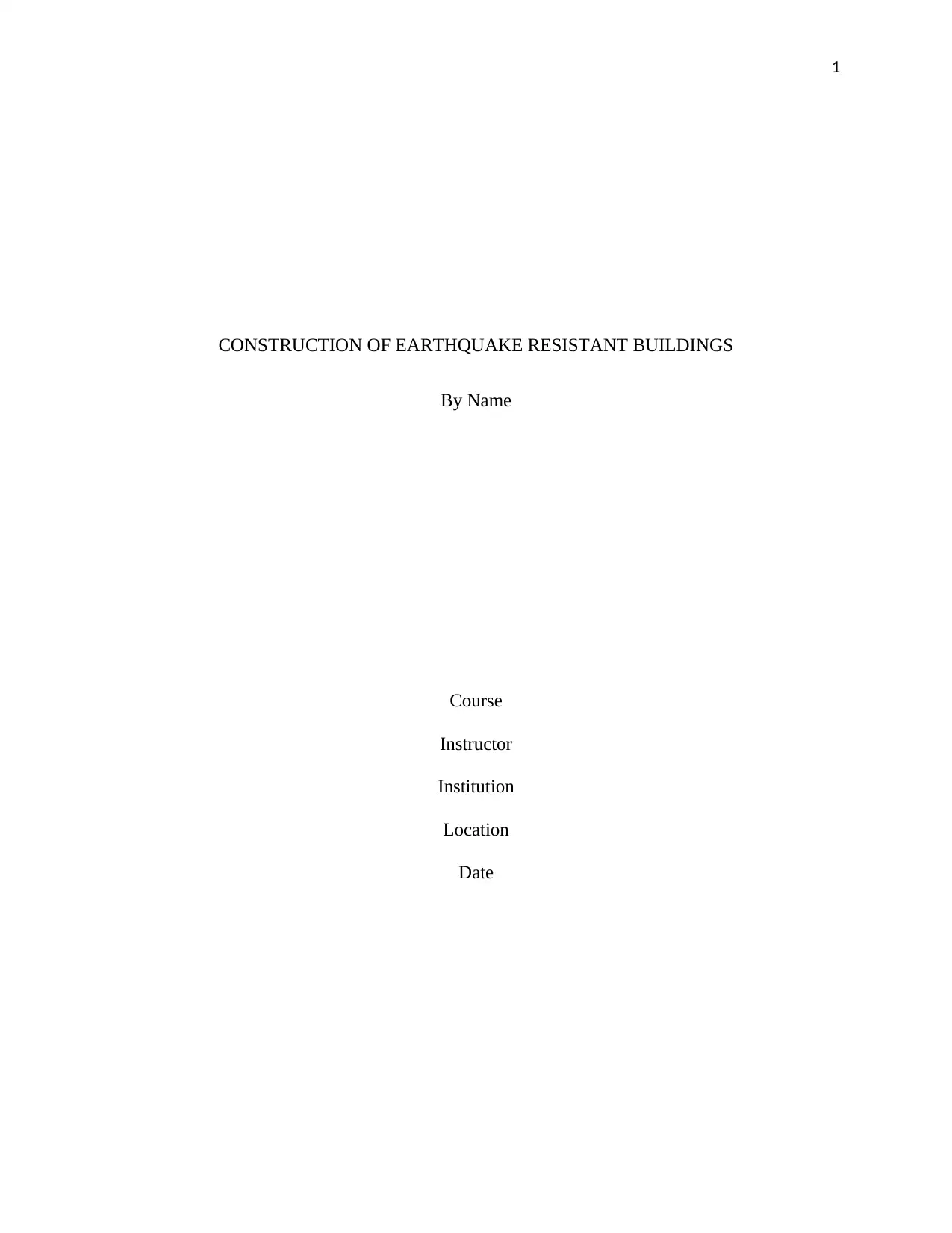
1
CONSTRUCTION OF EARTHQUAKE RESISTANT BUILDINGS
By Name
Course
Instructor
Institution
Location
Date
CONSTRUCTION OF EARTHQUAKE RESISTANT BUILDINGS
By Name
Course
Instructor
Institution
Location
Date
Paraphrase This Document
Need a fresh take? Get an instant paraphrase of this document with our AI Paraphraser
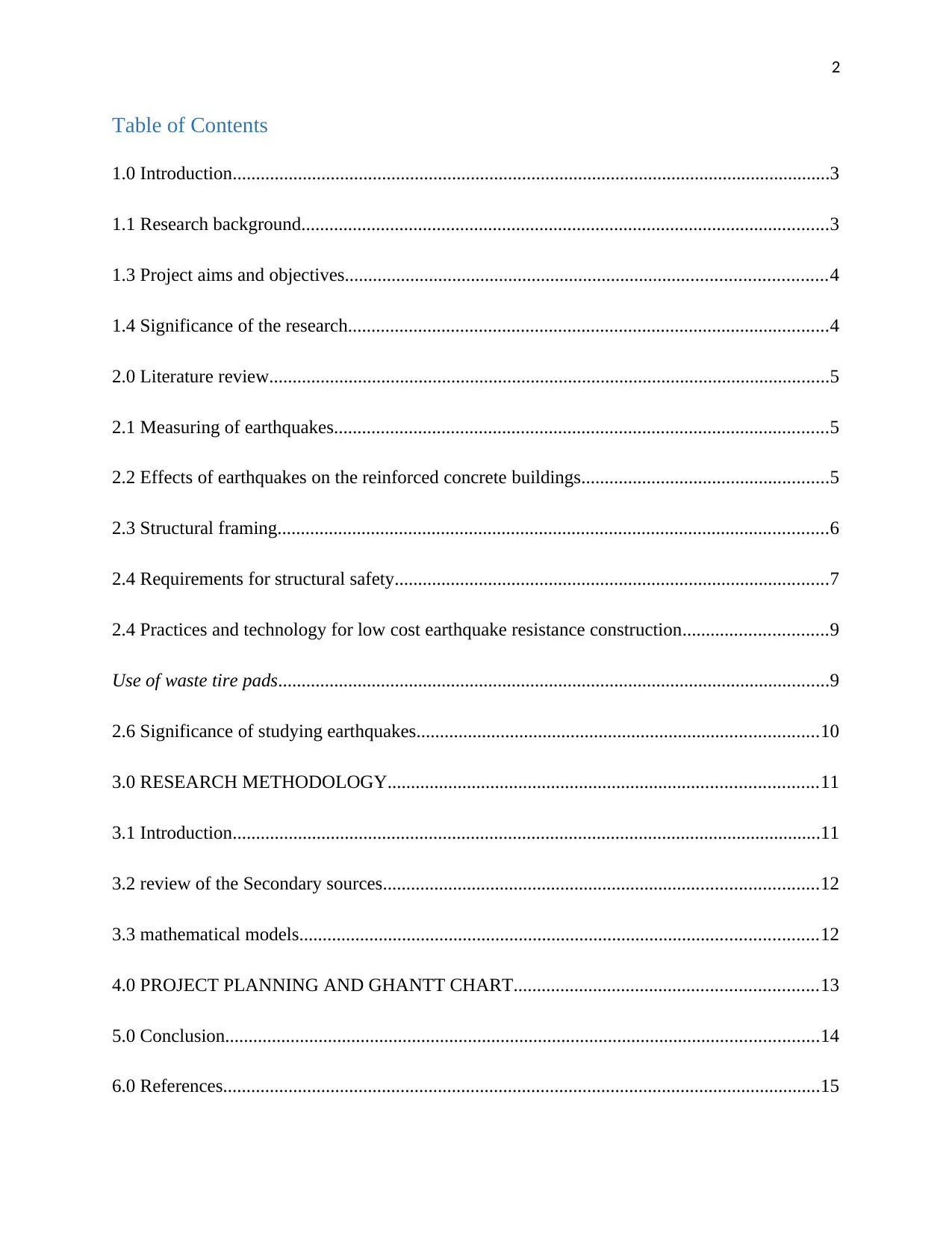
2
Table of Contents
1.0 Introduction................................................................................................................................3
1.1 Research background.................................................................................................................3
1.3 Project aims and objectives.......................................................................................................4
1.4 Significance of the research.......................................................................................................4
2.0 Literature review........................................................................................................................5
2.1 Measuring of earthquakes..........................................................................................................5
2.2 Effects of earthquakes on the reinforced concrete buildings.....................................................5
2.3 Structural framing......................................................................................................................6
2.4 Requirements for structural safety.............................................................................................7
2.4 Practices and technology for low cost earthquake resistance construction...............................9
Use of waste tire pads......................................................................................................................9
2.6 Significance of studying earthquakes......................................................................................10
3.0 RESEARCH METHODOLOGY............................................................................................11
3.1 Introduction..............................................................................................................................11
3.2 review of the Secondary sources.............................................................................................12
3.3 mathematical models...............................................................................................................12
4.0 PROJECT PLANNING AND GHANTT CHART.................................................................13
5.0 Conclusion...............................................................................................................................14
6.0 References................................................................................................................................15
Table of Contents
1.0 Introduction................................................................................................................................3
1.1 Research background.................................................................................................................3
1.3 Project aims and objectives.......................................................................................................4
1.4 Significance of the research.......................................................................................................4
2.0 Literature review........................................................................................................................5
2.1 Measuring of earthquakes..........................................................................................................5
2.2 Effects of earthquakes on the reinforced concrete buildings.....................................................5
2.3 Structural framing......................................................................................................................6
2.4 Requirements for structural safety.............................................................................................7
2.4 Practices and technology for low cost earthquake resistance construction...............................9
Use of waste tire pads......................................................................................................................9
2.6 Significance of studying earthquakes......................................................................................10
3.0 RESEARCH METHODOLOGY............................................................................................11
3.1 Introduction..............................................................................................................................11
3.2 review of the Secondary sources.............................................................................................12
3.3 mathematical models...............................................................................................................12
4.0 PROJECT PLANNING AND GHANTT CHART.................................................................13
5.0 Conclusion...............................................................................................................................14
6.0 References................................................................................................................................15
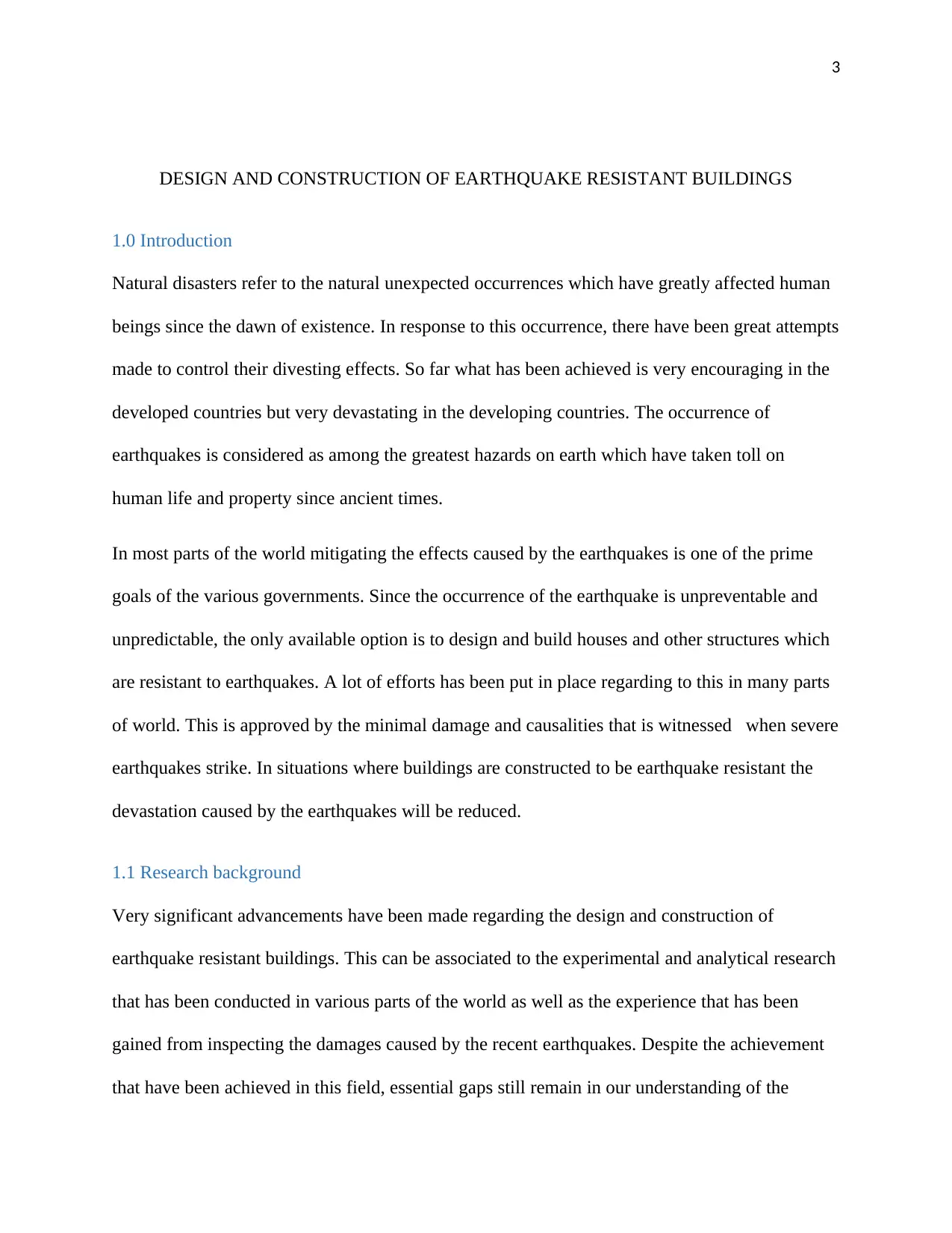
3
DESIGN AND CONSTRUCTION OF EARTHQUAKE RESISTANT BUILDINGS
1.0 Introduction
Natural disasters refer to the natural unexpected occurrences which have greatly affected human
beings since the dawn of existence. In response to this occurrence, there have been great attempts
made to control their divesting effects. So far what has been achieved is very encouraging in the
developed countries but very devastating in the developing countries. The occurrence of
earthquakes is considered as among the greatest hazards on earth which have taken toll on
human life and property since ancient times.
In most parts of the world mitigating the effects caused by the earthquakes is one of the prime
goals of the various governments. Since the occurrence of the earthquake is unpreventable and
unpredictable, the only available option is to design and build houses and other structures which
are resistant to earthquakes. A lot of efforts has been put in place regarding to this in many parts
of world. This is approved by the minimal damage and causalities that is witnessed when severe
earthquakes strike. In situations where buildings are constructed to be earthquake resistant the
devastation caused by the earthquakes will be reduced.
1.1 Research background
Very significant advancements have been made regarding the design and construction of
earthquake resistant buildings. This can be associated to the experimental and analytical research
that has been conducted in various parts of the world as well as the experience that has been
gained from inspecting the damages caused by the recent earthquakes. Despite the achievement
that have been achieved in this field, essential gaps still remain in our understanding of the
DESIGN AND CONSTRUCTION OF EARTHQUAKE RESISTANT BUILDINGS
1.0 Introduction
Natural disasters refer to the natural unexpected occurrences which have greatly affected human
beings since the dawn of existence. In response to this occurrence, there have been great attempts
made to control their divesting effects. So far what has been achieved is very encouraging in the
developed countries but very devastating in the developing countries. The occurrence of
earthquakes is considered as among the greatest hazards on earth which have taken toll on
human life and property since ancient times.
In most parts of the world mitigating the effects caused by the earthquakes is one of the prime
goals of the various governments. Since the occurrence of the earthquake is unpreventable and
unpredictable, the only available option is to design and build houses and other structures which
are resistant to earthquakes. A lot of efforts has been put in place regarding to this in many parts
of world. This is approved by the minimal damage and causalities that is witnessed when severe
earthquakes strike. In situations where buildings are constructed to be earthquake resistant the
devastation caused by the earthquakes will be reduced.
1.1 Research background
Very significant advancements have been made regarding the design and construction of
earthquake resistant buildings. This can be associated to the experimental and analytical research
that has been conducted in various parts of the world as well as the experience that has been
gained from inspecting the damages caused by the recent earthquakes. Despite the achievement
that have been achieved in this field, essential gaps still remain in our understanding of the
⊘ This is a preview!⊘
Do you want full access?
Subscribe today to unlock all pages.

Trusted by 1+ million students worldwide
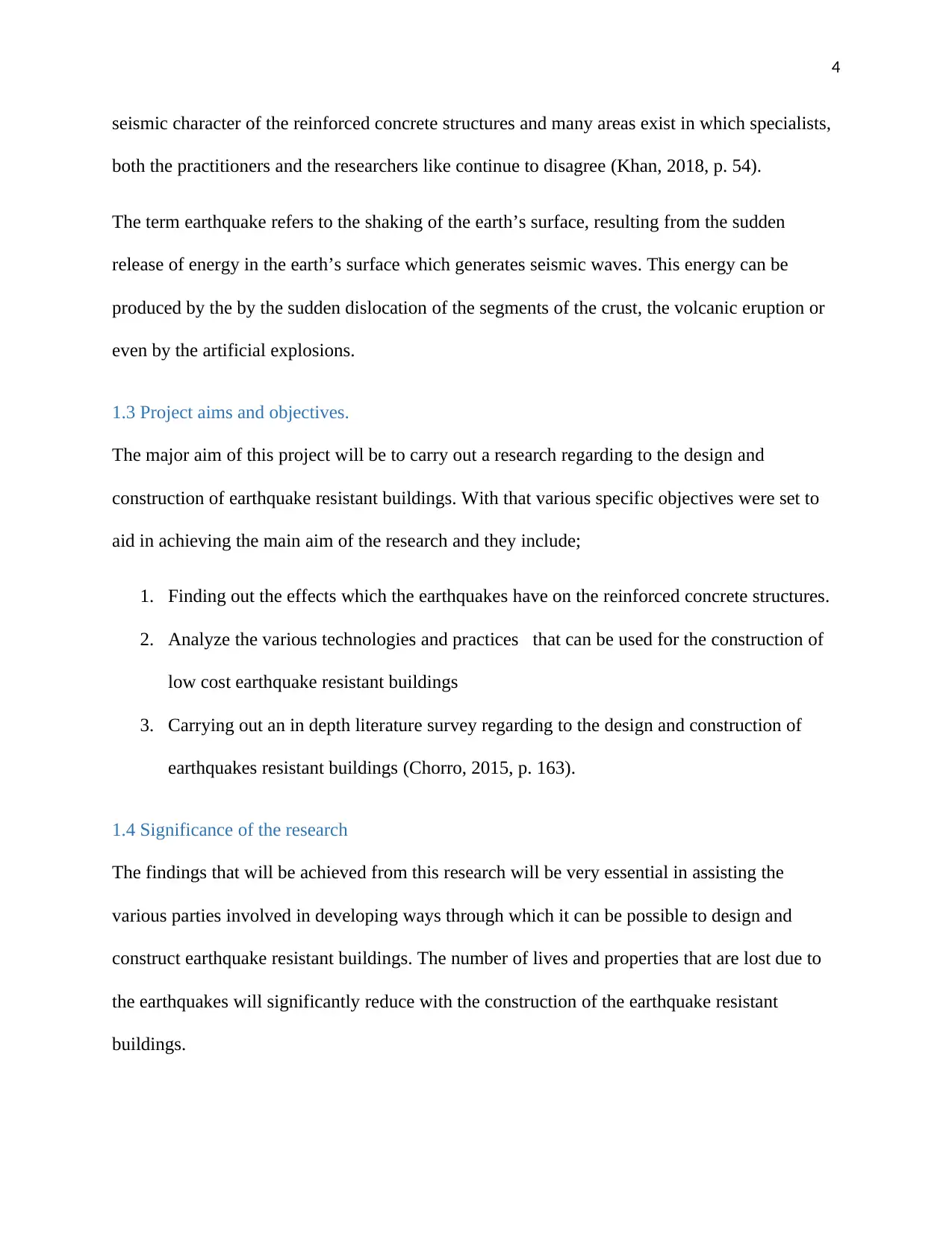
4
seismic character of the reinforced concrete structures and many areas exist in which specialists,
both the practitioners and the researchers like continue to disagree (Khan, 2018, p. 54).
The term earthquake refers to the shaking of the earth’s surface, resulting from the sudden
release of energy in the earth’s surface which generates seismic waves. This energy can be
produced by the by the sudden dislocation of the segments of the crust, the volcanic eruption or
even by the artificial explosions.
1.3 Project aims and objectives.
The major aim of this project will be to carry out a research regarding to the design and
construction of earthquake resistant buildings. With that various specific objectives were set to
aid in achieving the main aim of the research and they include;
1. Finding out the effects which the earthquakes have on the reinforced concrete structures.
2. Analyze the various technologies and practices that can be used for the construction of
low cost earthquake resistant buildings
3. Carrying out an in depth literature survey regarding to the design and construction of
earthquakes resistant buildings (Chorro, 2015, p. 163).
1.4 Significance of the research
The findings that will be achieved from this research will be very essential in assisting the
various parties involved in developing ways through which it can be possible to design and
construct earthquake resistant buildings. The number of lives and properties that are lost due to
the earthquakes will significantly reduce with the construction of the earthquake resistant
buildings.
seismic character of the reinforced concrete structures and many areas exist in which specialists,
both the practitioners and the researchers like continue to disagree (Khan, 2018, p. 54).
The term earthquake refers to the shaking of the earth’s surface, resulting from the sudden
release of energy in the earth’s surface which generates seismic waves. This energy can be
produced by the by the sudden dislocation of the segments of the crust, the volcanic eruption or
even by the artificial explosions.
1.3 Project aims and objectives.
The major aim of this project will be to carry out a research regarding to the design and
construction of earthquake resistant buildings. With that various specific objectives were set to
aid in achieving the main aim of the research and they include;
1. Finding out the effects which the earthquakes have on the reinforced concrete structures.
2. Analyze the various technologies and practices that can be used for the construction of
low cost earthquake resistant buildings
3. Carrying out an in depth literature survey regarding to the design and construction of
earthquakes resistant buildings (Chorro, 2015, p. 163).
1.4 Significance of the research
The findings that will be achieved from this research will be very essential in assisting the
various parties involved in developing ways through which it can be possible to design and
construct earthquake resistant buildings. The number of lives and properties that are lost due to
the earthquakes will significantly reduce with the construction of the earthquake resistant
buildings.
Paraphrase This Document
Need a fresh take? Get an instant paraphrase of this document with our AI Paraphraser
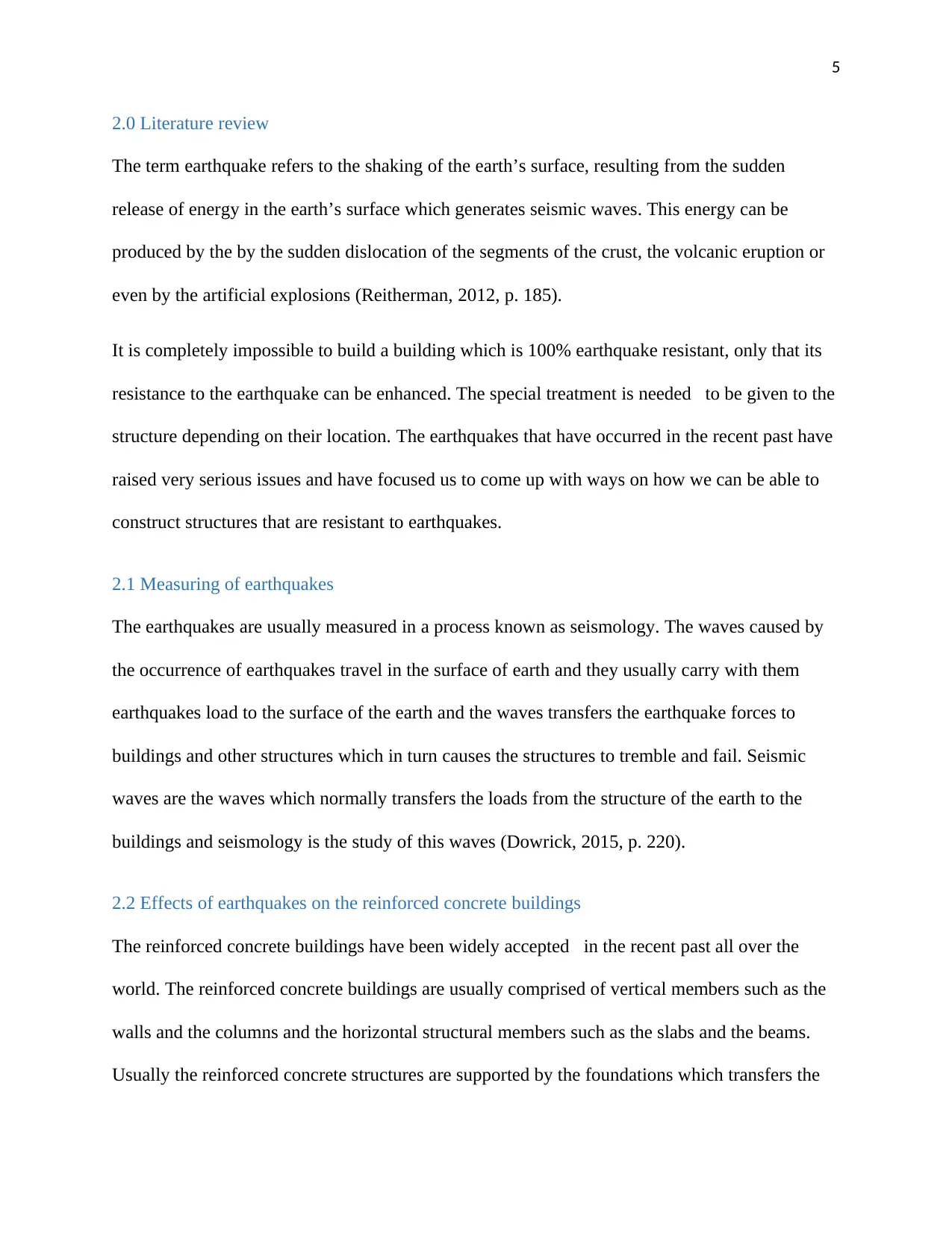
5
2.0 Literature review
The term earthquake refers to the shaking of the earth’s surface, resulting from the sudden
release of energy in the earth’s surface which generates seismic waves. This energy can be
produced by the by the sudden dislocation of the segments of the crust, the volcanic eruption or
even by the artificial explosions (Reitherman, 2012, p. 185).
It is completely impossible to build a building which is 100% earthquake resistant, only that its
resistance to the earthquake can be enhanced. The special treatment is needed to be given to the
structure depending on their location. The earthquakes that have occurred in the recent past have
raised very serious issues and have focused us to come up with ways on how we can be able to
construct structures that are resistant to earthquakes.
2.1 Measuring of earthquakes
The earthquakes are usually measured in a process known as seismology. The waves caused by
the occurrence of earthquakes travel in the surface of earth and they usually carry with them
earthquakes load to the surface of the earth and the waves transfers the earthquake forces to
buildings and other structures which in turn causes the structures to tremble and fail. Seismic
waves are the waves which normally transfers the loads from the structure of the earth to the
buildings and seismology is the study of this waves (Dowrick, 2015, p. 220).
2.2 Effects of earthquakes on the reinforced concrete buildings
The reinforced concrete buildings have been widely accepted in the recent past all over the
world. The reinforced concrete buildings are usually comprised of vertical members such as the
walls and the columns and the horizontal structural members such as the slabs and the beams.
Usually the reinforced concrete structures are supported by the foundations which transfers the
2.0 Literature review
The term earthquake refers to the shaking of the earth’s surface, resulting from the sudden
release of energy in the earth’s surface which generates seismic waves. This energy can be
produced by the by the sudden dislocation of the segments of the crust, the volcanic eruption or
even by the artificial explosions (Reitherman, 2012, p. 185).
It is completely impossible to build a building which is 100% earthquake resistant, only that its
resistance to the earthquake can be enhanced. The special treatment is needed to be given to the
structure depending on their location. The earthquakes that have occurred in the recent past have
raised very serious issues and have focused us to come up with ways on how we can be able to
construct structures that are resistant to earthquakes.
2.1 Measuring of earthquakes
The earthquakes are usually measured in a process known as seismology. The waves caused by
the occurrence of earthquakes travel in the surface of earth and they usually carry with them
earthquakes load to the surface of the earth and the waves transfers the earthquake forces to
buildings and other structures which in turn causes the structures to tremble and fail. Seismic
waves are the waves which normally transfers the loads from the structure of the earth to the
buildings and seismology is the study of this waves (Dowrick, 2015, p. 220).
2.2 Effects of earthquakes on the reinforced concrete buildings
The reinforced concrete buildings have been widely accepted in the recent past all over the
world. The reinforced concrete buildings are usually comprised of vertical members such as the
walls and the columns and the horizontal structural members such as the slabs and the beams.
Usually the reinforced concrete structures are supported by the foundations which transfers the
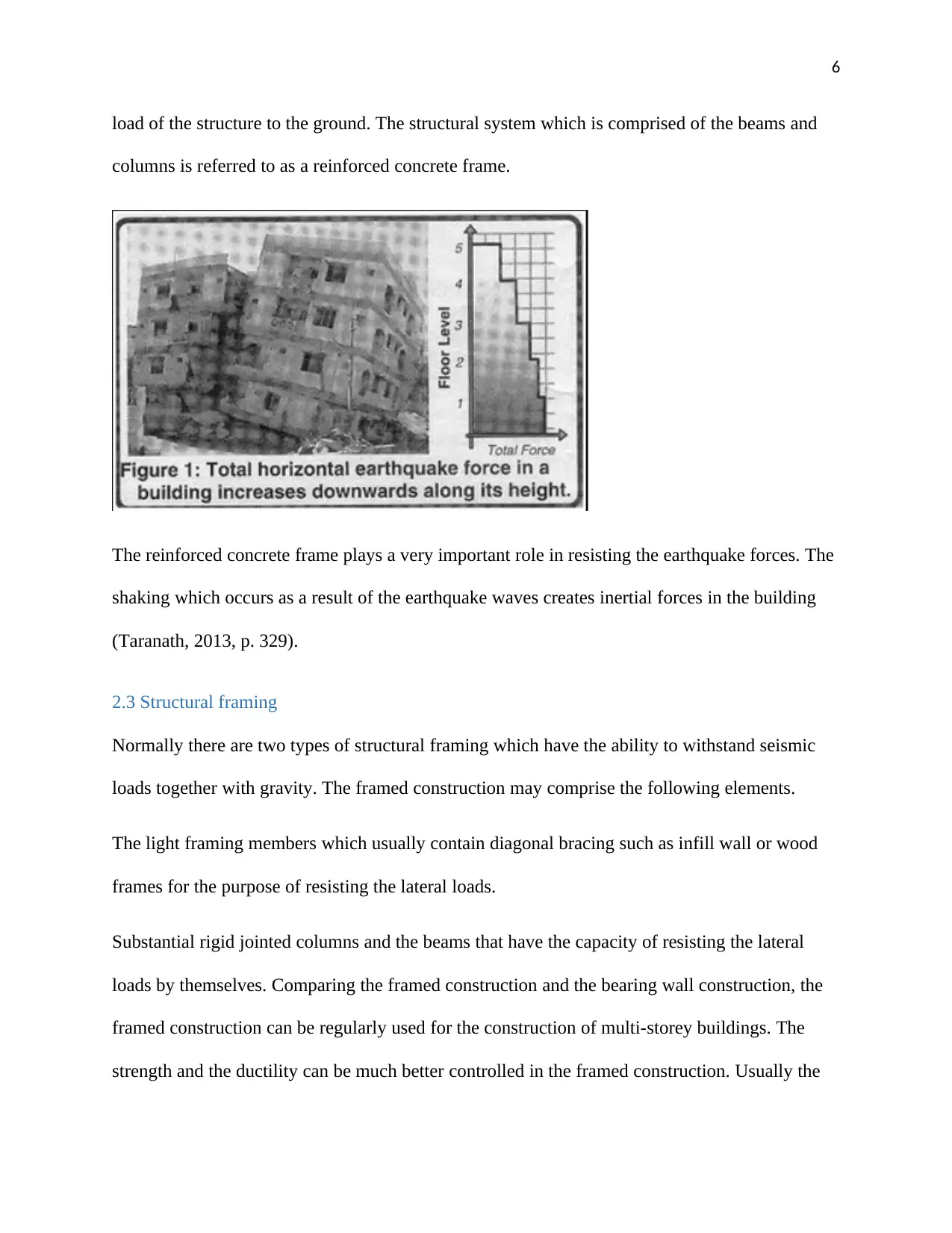
6
load of the structure to the ground. The structural system which is comprised of the beams and
columns is referred to as a reinforced concrete frame.
The reinforced concrete frame plays a very important role in resisting the earthquake forces. The
shaking which occurs as a result of the earthquake waves creates inertial forces in the building
(Taranath, 2013, p. 329).
2.3 Structural framing
Normally there are two types of structural framing which have the ability to withstand seismic
loads together with gravity. The framed construction may comprise the following elements.
The light framing members which usually contain diagonal bracing such as infill wall or wood
frames for the purpose of resisting the lateral loads.
Substantial rigid jointed columns and the beams that have the capacity of resisting the lateral
loads by themselves. Comparing the framed construction and the bearing wall construction, the
framed construction can be regularly used for the construction of multi-storey buildings. The
strength and the ductility can be much better controlled in the framed construction. Usually the
load of the structure to the ground. The structural system which is comprised of the beams and
columns is referred to as a reinforced concrete frame.
The reinforced concrete frame plays a very important role in resisting the earthquake forces. The
shaking which occurs as a result of the earthquake waves creates inertial forces in the building
(Taranath, 2013, p. 329).
2.3 Structural framing
Normally there are two types of structural framing which have the ability to withstand seismic
loads together with gravity. The framed construction may comprise the following elements.
The light framing members which usually contain diagonal bracing such as infill wall or wood
frames for the purpose of resisting the lateral loads.
Substantial rigid jointed columns and the beams that have the capacity of resisting the lateral
loads by themselves. Comparing the framed construction and the bearing wall construction, the
framed construction can be regularly used for the construction of multi-storey buildings. The
strength and the ductility can be much better controlled in the framed construction. Usually the
⊘ This is a preview!⊘
Do you want full access?
Subscribe today to unlock all pages.

Trusted by 1+ million students worldwide
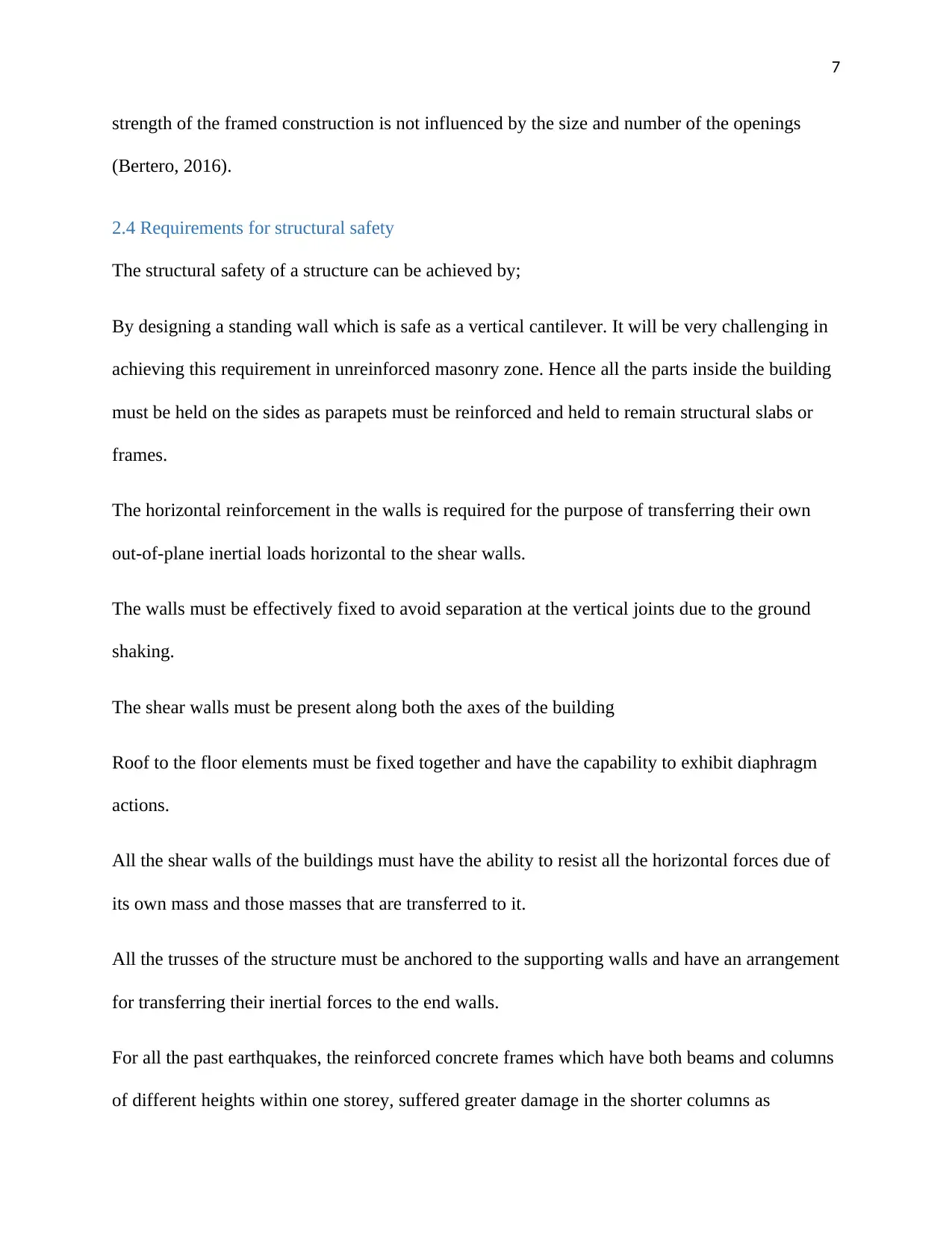
7
strength of the framed construction is not influenced by the size and number of the openings
(Bertero, 2016).
2.4 Requirements for structural safety
The structural safety of a structure can be achieved by;
By designing a standing wall which is safe as a vertical cantilever. It will be very challenging in
achieving this requirement in unreinforced masonry zone. Hence all the parts inside the building
must be held on the sides as parapets must be reinforced and held to remain structural slabs or
frames.
The horizontal reinforcement in the walls is required for the purpose of transferring their own
out-of-plane inertial loads horizontal to the shear walls.
The walls must be effectively fixed to avoid separation at the vertical joints due to the ground
shaking.
The shear walls must be present along both the axes of the building
Roof to the floor elements must be fixed together and have the capability to exhibit diaphragm
actions.
All the shear walls of the buildings must have the ability to resist all the horizontal forces due of
its own mass and those masses that are transferred to it.
All the trusses of the structure must be anchored to the supporting walls and have an arrangement
for transferring their inertial forces to the end walls.
For all the past earthquakes, the reinforced concrete frames which have both beams and columns
of different heights within one storey, suffered greater damage in the shorter columns as
strength of the framed construction is not influenced by the size and number of the openings
(Bertero, 2016).
2.4 Requirements for structural safety
The structural safety of a structure can be achieved by;
By designing a standing wall which is safe as a vertical cantilever. It will be very challenging in
achieving this requirement in unreinforced masonry zone. Hence all the parts inside the building
must be held on the sides as parapets must be reinforced and held to remain structural slabs or
frames.
The horizontal reinforcement in the walls is required for the purpose of transferring their own
out-of-plane inertial loads horizontal to the shear walls.
The walls must be effectively fixed to avoid separation at the vertical joints due to the ground
shaking.
The shear walls must be present along both the axes of the building
Roof to the floor elements must be fixed together and have the capability to exhibit diaphragm
actions.
All the shear walls of the buildings must have the ability to resist all the horizontal forces due of
its own mass and those masses that are transferred to it.
All the trusses of the structure must be anchored to the supporting walls and have an arrangement
for transferring their inertial forces to the end walls.
For all the past earthquakes, the reinforced concrete frames which have both beams and columns
of different heights within one storey, suffered greater damage in the shorter columns as
Paraphrase This Document
Need a fresh take? Get an instant paraphrase of this document with our AI Paraphraser
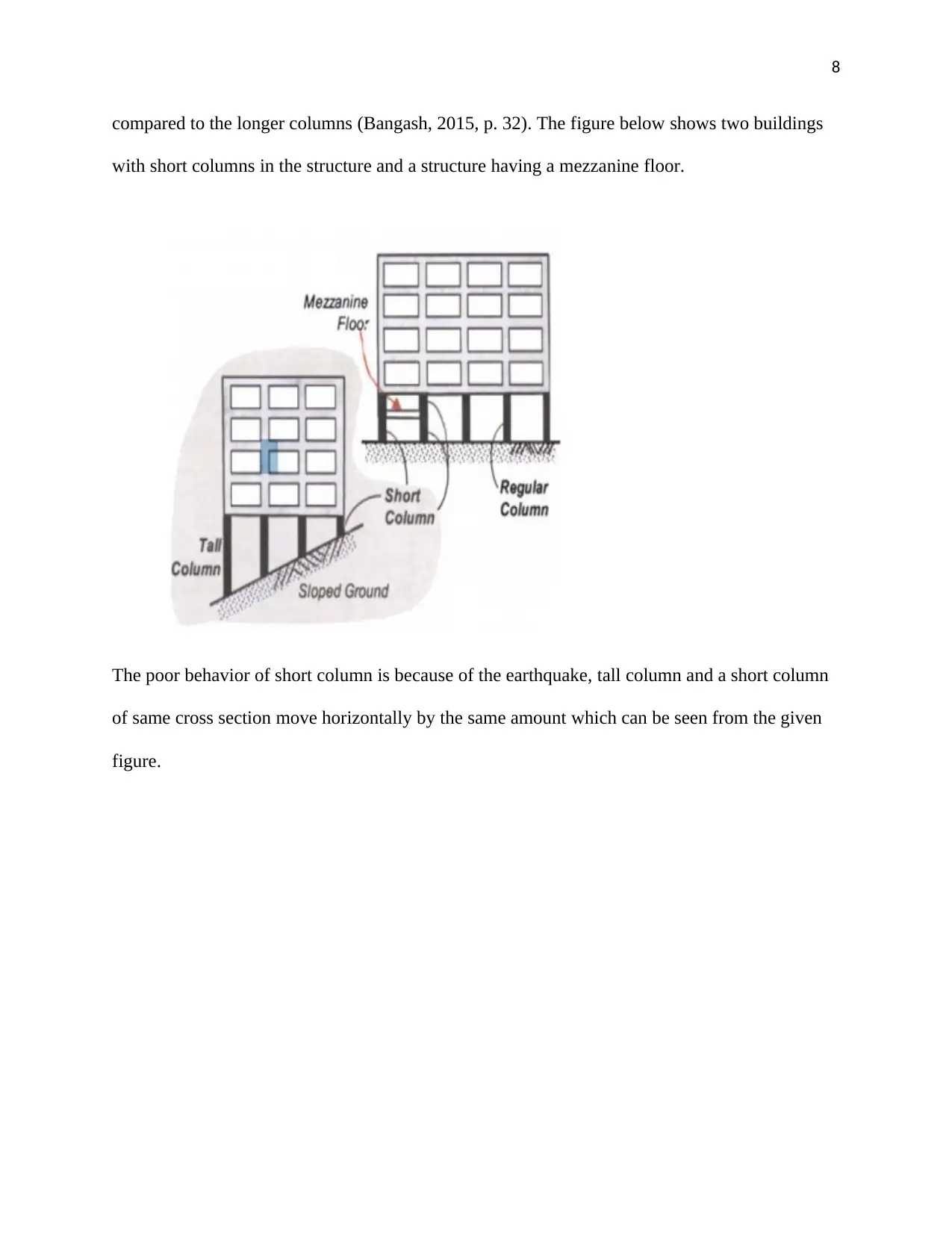
8
compared to the longer columns (Bangash, 2015, p. 32). The figure below shows two buildings
with short columns in the structure and a structure having a mezzanine floor.
The poor behavior of short column is because of the earthquake, tall column and a short column
of same cross section move horizontally by the same amount which can be seen from the given
figure.
compared to the longer columns (Bangash, 2015, p. 32). The figure below shows two buildings
with short columns in the structure and a structure having a mezzanine floor.
The poor behavior of short column is because of the earthquake, tall column and a short column
of same cross section move horizontally by the same amount which can be seen from the given
figure.
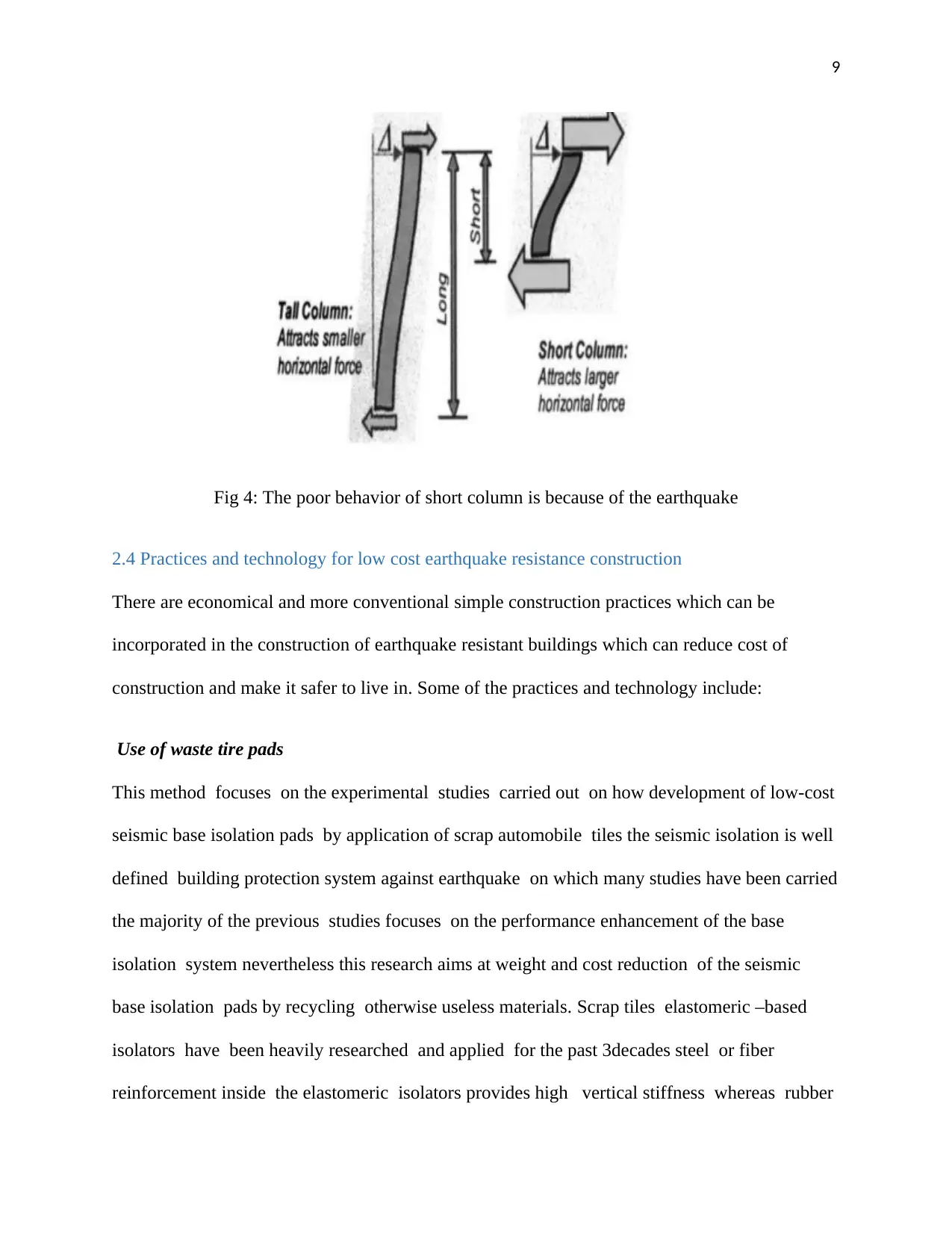
9
Fig 4: The poor behavior of short column is because of the earthquake
2.4 Practices and technology for low cost earthquake resistance construction
There are economical and more conventional simple construction practices which can be
incorporated in the construction of earthquake resistant buildings which can reduce cost of
construction and make it safer to live in. Some of the practices and technology include:
Use of waste tire pads
This method focuses on the experimental studies carried out on how development of low-cost
seismic base isolation pads by application of scrap automobile tiles the seismic isolation is well
defined building protection system against earthquake on which many studies have been carried
the majority of the previous studies focuses on the performance enhancement of the base
isolation system nevertheless this research aims at weight and cost reduction of the seismic
base isolation pads by recycling otherwise useless materials. Scrap tiles elastomeric –based
isolators have been heavily researched and applied for the past 3decades steel or fiber
reinforcement inside the elastomeric isolators provides high vertical stiffness whereas rubber
Fig 4: The poor behavior of short column is because of the earthquake
2.4 Practices and technology for low cost earthquake resistance construction
There are economical and more conventional simple construction practices which can be
incorporated in the construction of earthquake resistant buildings which can reduce cost of
construction and make it safer to live in. Some of the practices and technology include:
Use of waste tire pads
This method focuses on the experimental studies carried out on how development of low-cost
seismic base isolation pads by application of scrap automobile tiles the seismic isolation is well
defined building protection system against earthquake on which many studies have been carried
the majority of the previous studies focuses on the performance enhancement of the base
isolation system nevertheless this research aims at weight and cost reduction of the seismic
base isolation pads by recycling otherwise useless materials. Scrap tiles elastomeric –based
isolators have been heavily researched and applied for the past 3decades steel or fiber
reinforcement inside the elastomeric isolators provides high vertical stiffness whereas rubber
⊘ This is a preview!⊘
Do you want full access?
Subscribe today to unlock all pages.

Trusted by 1+ million students worldwide
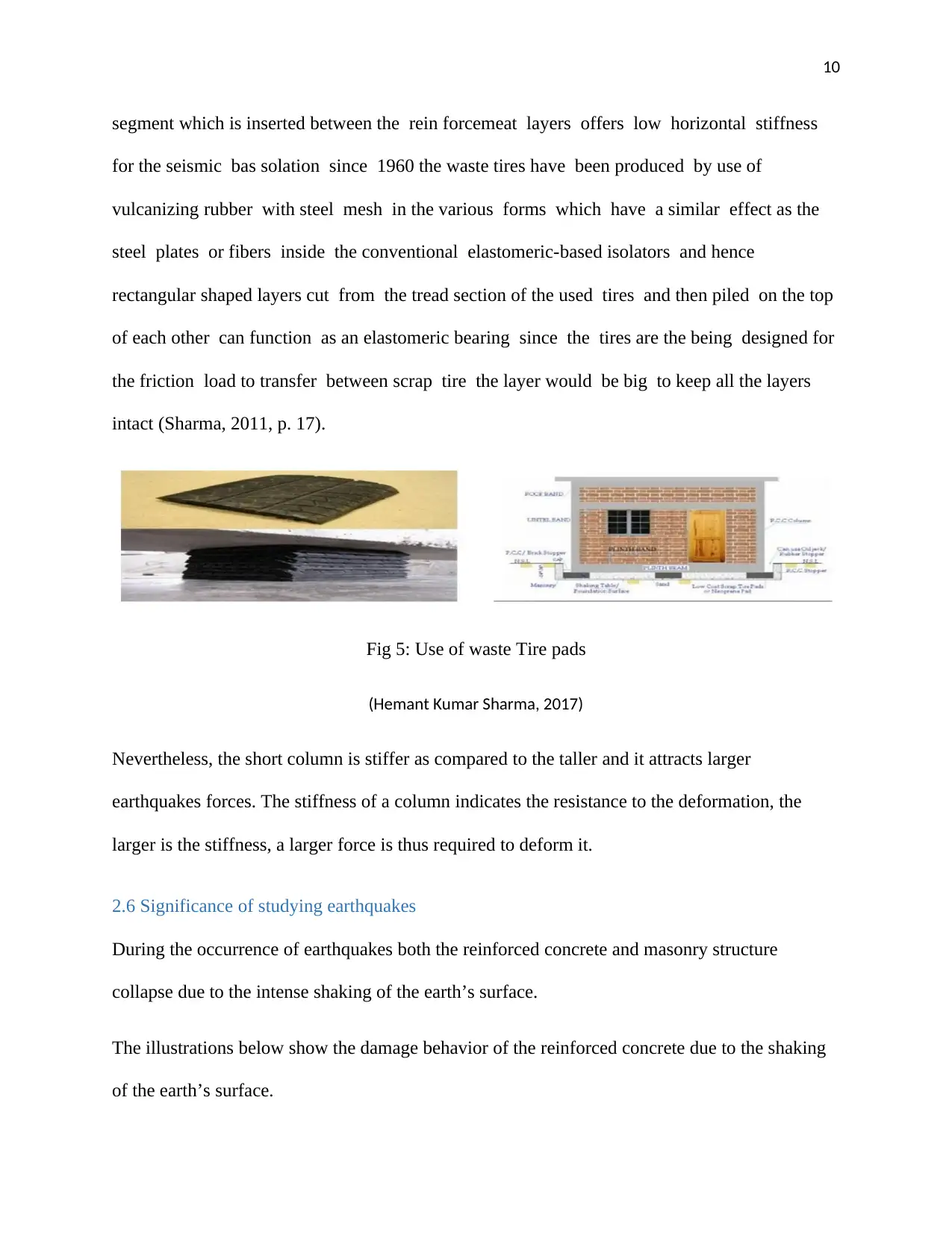
10
segment which is inserted between the rein forcemeat layers offers low horizontal stiffness
for the seismic bas solation since 1960 the waste tires have been produced by use of
vulcanizing rubber with steel mesh in the various forms which have a similar effect as the
steel plates or fibers inside the conventional elastomeric-based isolators and hence
rectangular shaped layers cut from the tread section of the used tires and then piled on the top
of each other can function as an elastomeric bearing since the tires are the being designed for
the friction load to transfer between scrap tire the layer would be big to keep all the layers
intact (Sharma, 2011, p. 17).
Fig 5: Use of waste Tire pads
(Hemant Kumar Sharma, 2017)
Nevertheless, the short column is stiffer as compared to the taller and it attracts larger
earthquakes forces. The stiffness of a column indicates the resistance to the deformation, the
larger is the stiffness, a larger force is thus required to deform it.
2.6 Significance of studying earthquakes
During the occurrence of earthquakes both the reinforced concrete and masonry structure
collapse due to the intense shaking of the earth’s surface.
The illustrations below show the damage behavior of the reinforced concrete due to the shaking
of the earth’s surface.
segment which is inserted between the rein forcemeat layers offers low horizontal stiffness
for the seismic bas solation since 1960 the waste tires have been produced by use of
vulcanizing rubber with steel mesh in the various forms which have a similar effect as the
steel plates or fibers inside the conventional elastomeric-based isolators and hence
rectangular shaped layers cut from the tread section of the used tires and then piled on the top
of each other can function as an elastomeric bearing since the tires are the being designed for
the friction load to transfer between scrap tire the layer would be big to keep all the layers
intact (Sharma, 2011, p. 17).
Fig 5: Use of waste Tire pads
(Hemant Kumar Sharma, 2017)
Nevertheless, the short column is stiffer as compared to the taller and it attracts larger
earthquakes forces. The stiffness of a column indicates the resistance to the deformation, the
larger is the stiffness, a larger force is thus required to deform it.
2.6 Significance of studying earthquakes
During the occurrence of earthquakes both the reinforced concrete and masonry structure
collapse due to the intense shaking of the earth’s surface.
The illustrations below show the damage behavior of the reinforced concrete due to the shaking
of the earth’s surface.
Paraphrase This Document
Need a fresh take? Get an instant paraphrase of this document with our AI Paraphraser
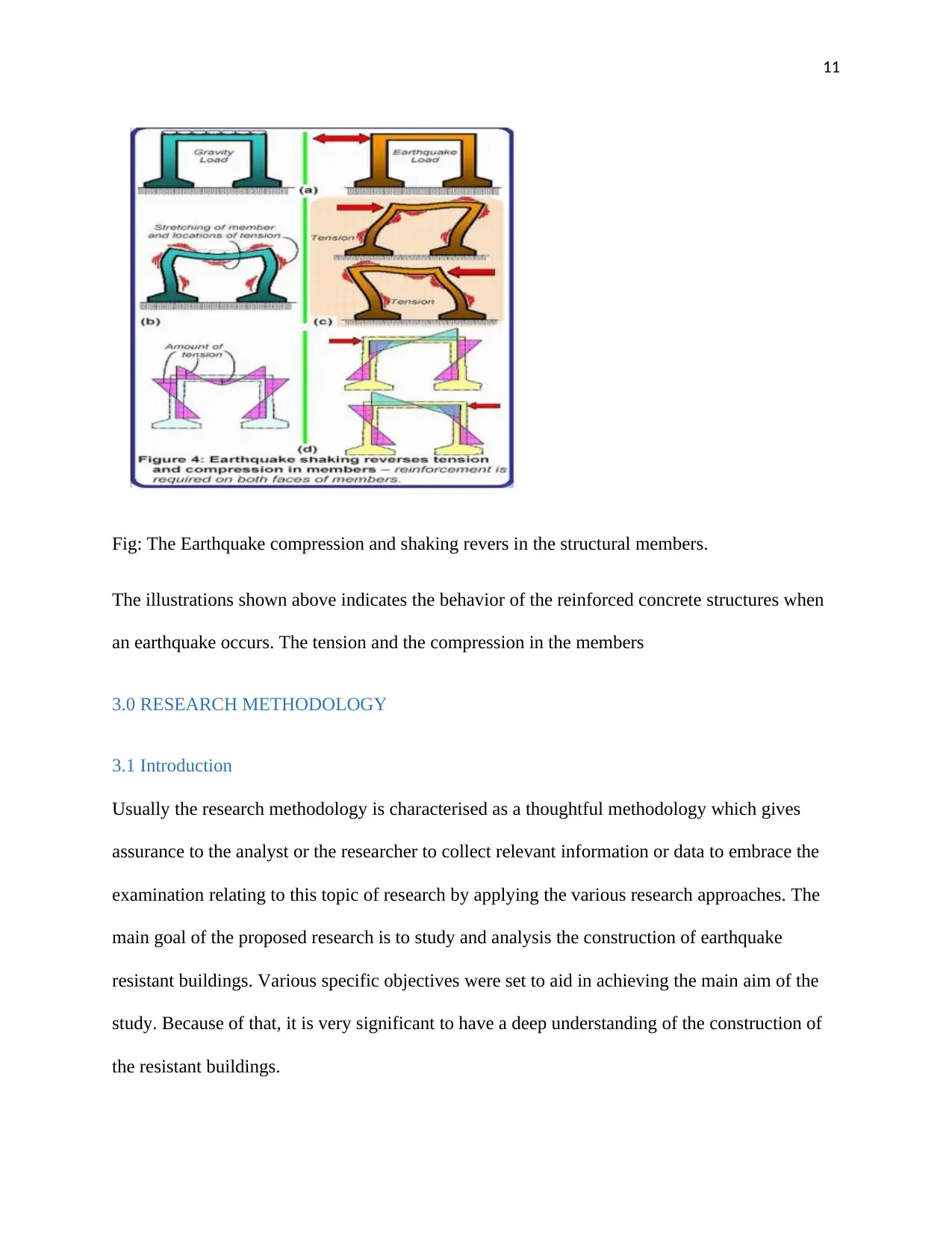
11
Fig: The Earthquake compression and shaking revers in the structural members.
The illustrations shown above indicates the behavior of the reinforced concrete structures when
an earthquake occurs. The tension and the compression in the members
3.0 RESEARCH METHODOLOGY
3.1 Introduction
Usually the research methodology is characterised as a thoughtful methodology which gives
assurance to the analyst or the researcher to collect relevant information or data to embrace the
examination relating to this topic of research by applying the various research approaches. The
main goal of the proposed research is to study and analysis the construction of earthquake
resistant buildings. Various specific objectives were set to aid in achieving the main aim of the
study. Because of that, it is very significant to have a deep understanding of the construction of
the resistant buildings.
Fig: The Earthquake compression and shaking revers in the structural members.
The illustrations shown above indicates the behavior of the reinforced concrete structures when
an earthquake occurs. The tension and the compression in the members
3.0 RESEARCH METHODOLOGY
3.1 Introduction
Usually the research methodology is characterised as a thoughtful methodology which gives
assurance to the analyst or the researcher to collect relevant information or data to embrace the
examination relating to this topic of research by applying the various research approaches. The
main goal of the proposed research is to study and analysis the construction of earthquake
resistant buildings. Various specific objectives were set to aid in achieving the main aim of the
study. Because of that, it is very significant to have a deep understanding of the construction of
the resistant buildings.
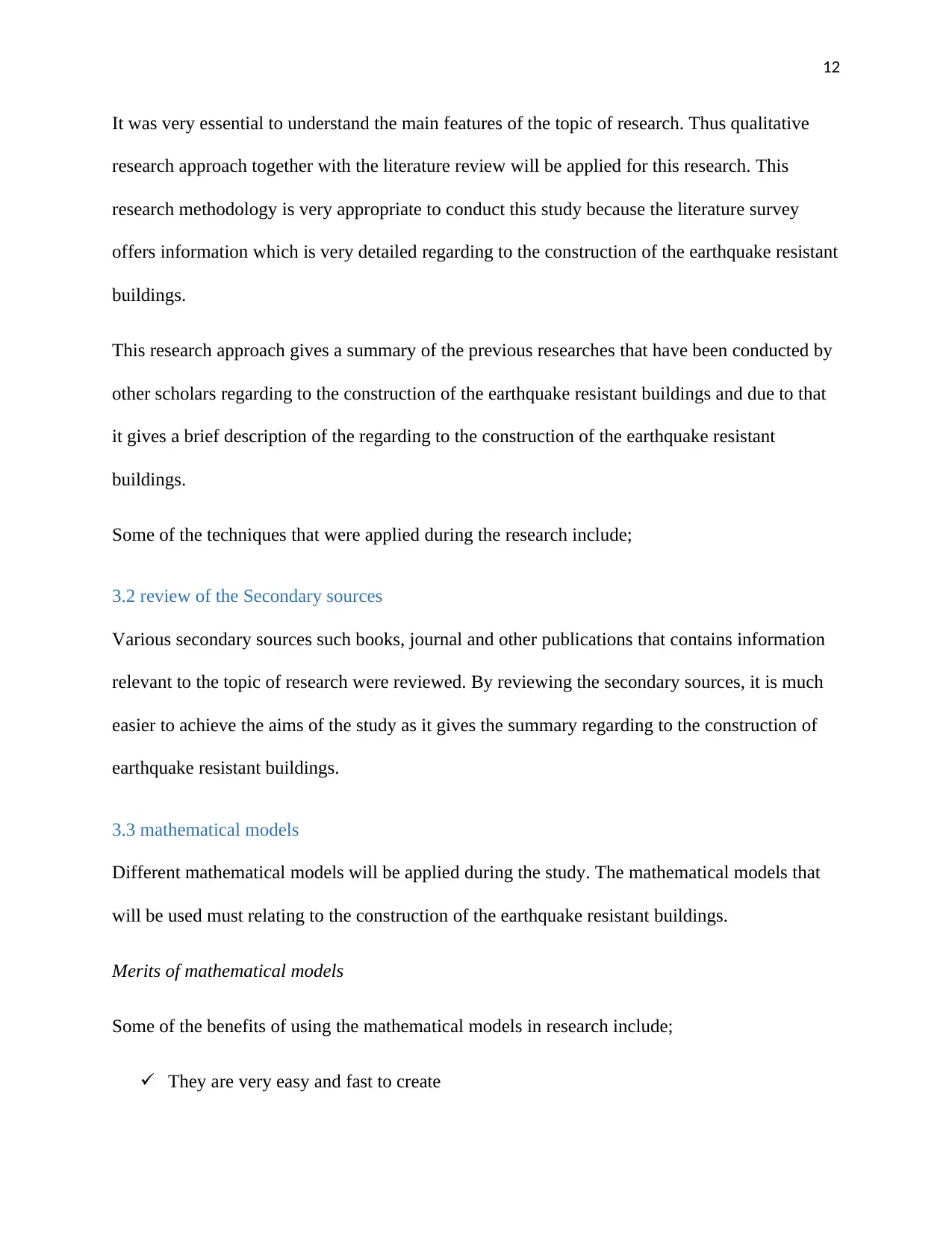
12
It was very essential to understand the main features of the topic of research. Thus qualitative
research approach together with the literature review will be applied for this research. This
research methodology is very appropriate to conduct this study because the literature survey
offers information which is very detailed regarding to the construction of the earthquake resistant
buildings.
This research approach gives a summary of the previous researches that have been conducted by
other scholars regarding to the construction of the earthquake resistant buildings and due to that
it gives a brief description of the regarding to the construction of the earthquake resistant
buildings.
Some of the techniques that were applied during the research include;
3.2 review of the Secondary sources
Various secondary sources such books, journal and other publications that contains information
relevant to the topic of research were reviewed. By reviewing the secondary sources, it is much
easier to achieve the aims of the study as it gives the summary regarding to the construction of
earthquake resistant buildings.
3.3 mathematical models
Different mathematical models will be applied during the study. The mathematical models that
will be used must relating to the construction of the earthquake resistant buildings.
Merits of mathematical models
Some of the benefits of using the mathematical models in research include;
They are very easy and fast to create
It was very essential to understand the main features of the topic of research. Thus qualitative
research approach together with the literature review will be applied for this research. This
research methodology is very appropriate to conduct this study because the literature survey
offers information which is very detailed regarding to the construction of the earthquake resistant
buildings.
This research approach gives a summary of the previous researches that have been conducted by
other scholars regarding to the construction of the earthquake resistant buildings and due to that
it gives a brief description of the regarding to the construction of the earthquake resistant
buildings.
Some of the techniques that were applied during the research include;
3.2 review of the Secondary sources
Various secondary sources such books, journal and other publications that contains information
relevant to the topic of research were reviewed. By reviewing the secondary sources, it is much
easier to achieve the aims of the study as it gives the summary regarding to the construction of
earthquake resistant buildings.
3.3 mathematical models
Different mathematical models will be applied during the study. The mathematical models that
will be used must relating to the construction of the earthquake resistant buildings.
Merits of mathematical models
Some of the benefits of using the mathematical models in research include;
They are very easy and fast to create
⊘ This is a preview!⊘
Do you want full access?
Subscribe today to unlock all pages.

Trusted by 1+ million students worldwide
1 out of 16
Related Documents
Your All-in-One AI-Powered Toolkit for Academic Success.
+13062052269
info@desklib.com
Available 24*7 on WhatsApp / Email
![[object Object]](/_next/static/media/star-bottom.7253800d.svg)
Unlock your academic potential
Copyright © 2020–2025 A2Z Services. All Rights Reserved. Developed and managed by ZUCOL.



